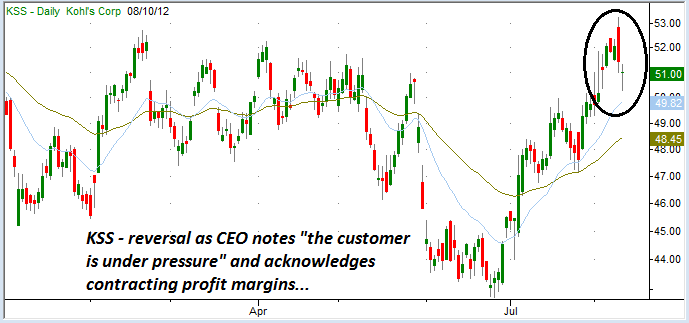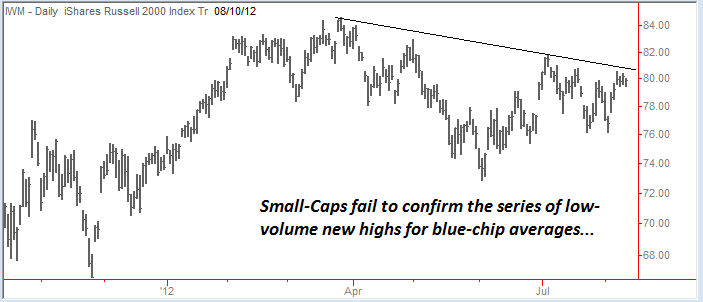The trading environment for US equities has become eerily quiet as we wind down the second quarter earnings season.
It’s normal to expect light trading during the summer as institutional traders take vacations and retail capital flows remain quiet. But last week’s action took ‘illiquidity‘ to a whole new level.
For the week, the Dow put in its smallest weekly range since 2007, and trading volumes are at 5-year lows. This during a time when the global macro risks continue to rise, setting up potential for an unexpected air pocket in the near-term price action.
Narrow trading ranges have the tendency to induce complacency, as traders get comfortable with the muted price action, and risk models expand allowable exposure levels. At the same time, lower volume decreases the amount of liquidity available to traders – which can be a big problem if capital needs to be moved quickly.
The complacency and lack of liquidity is especially concerning when considering the numerous potential catalysts that could easily ignite a selloff…
- In Europe, politicians continue to fight crisis with words, but have been unable to come up with any credible plans to solve the debt issues, or to re-ignite economic growth. European equity markets have rebounded from oversold levels, squeezing shorts and sucking in new optimistic buyers. But without any true solution to the crisis, the price action looks very much like an unsustainable relief rally.
- In China, disappointing export data highlights the degree to which the world’s largest ‘growth’ economy relies on the developed world to maintain expansion levels. For the month of July, exports rose only 1% year-over-year, with exports to the euro-zone down 16%. New bank lending also hit a 10-month low even as policies were loosened to make credit more readily available.
- Here in the US, the second quarter earnings season has been a fundamental disaster, with revenue figures coming in below expectations and corporations lowering guidance broadly. The consumer spending picture continues to weaken for both budget conscious and affluent retailers. And while headline employment numbers show improvement, the details still point to weakness, as underemployment is high coupled with a low labor participation rate.
The current bull market appears very vulnerable as prices grind higher on extremely low volume. The broad indices have traded up to key resistance areas (without breaking out), and the majority of sectors are now in overbought territory.
We’re entering the week with some broad bearish exposure already on the books, and looking to add sector and individual equity positions on a case-by-case basis.
Of course we continue to respect the recent grind-higher price action. But considering the low volume, the lack of compelling fundamental data, and the relative complacency, bearish trades popping up on our radar offer compelling reward-to-risk scenarios.
Below are a few of the areas we are focusing on this week…
More Evidence Of Consumer Weakness
Over the past week, two major earnings reports shed more light on the fragile state of the US retail environment.
On Thursday, Kohl’s Corp (KSS) reported an earnings beat as depressed expectations set a low hurdle for the current quarter. But more importantly, the company cut their full year outlook, and CEO Kevin Mansell stated that they would have to cut prices to help move inventory off shelves.
During the conference call, Mansell noted that their customers are under pressure, and that the company would have to accept lower profit margins in order to keep revenues stable.
On Friday, J.C. Penny (JCP) announced a loss that was much worse than expectations, on revenue that was 23% lower than last year.
Consumers are not reacting well to the department store’s new policy of not offering discounts (opting for an ‘every-day-low-price’ format). Ironically, the stock rallied 6% on the news…
The J.C. Penny example illustrates two important issues for trading this environment.
- US Consumers are price conscious. Retailers are being forced to compete based on price, and promotions are necessary to attract sales. This makes it difficult for investors to justify premium growth multiples for retail stocks.
- Oversold stocks are vulnerable to short squeezes. In the case of JCP, the stock had already lost more than 50% of its value from earlier this year. Oversold stocks can be extremely vulnerable to “short the rumor, cover on the news” squeezes.

Traders should keep a close eye on Dillard’s Inc. (DDS) and Nordstrom, Inc. (JWN) as additional industry tells.
Dillards broke to a new high last week, but volume was much lower than the stock experienced during its last breakout (exhaustion gap?). Nordstrom on the other hand is advancing steadily right into a key resistance area.
Weakness for either of these retailers could have a profound effect on sentiment for department store investors, as the entire group relies on robust consumer spending for growth.
Transports Fail To Confirm Market Strength
While the blue-chip indices have been grinding higher on declining volume, the Dow Jones Transportation Index ($TRAN) has been trading in a giant wedge pattern. A sustained series of lower highs raises a red flag for Dow Theory practitioners.
The action in the transports more closely reflects the global economic picture, and at least on the retail side, a slowdown in transportation meshes with retailers and wholesalers reporting high inventory levels and slow turnover.
More specifically, North American trucking stocks have been looking vulnerable as lower volumes lead to compressed profit margins.
J.B. Hunt Transport Services (JBHT) is one component that looks attractive from the short side, after a failed breakout early this summer, and a disappointing earnings announcement last month.
On June 17, the company missed earnings and revenue projections, sending the stock sharply lower. The miss would have been worse if not for falling oil prices through much of the second quarter.
With oil prices moving materially higher since the start of the month, and global trade showing signs of topping out, it’s easy to see why the stock hasn’t made back lost ground – even with the broad market providing a tailwind.
J.B. Hunt currently trades with a growth-stock multiple as expectations for a slow but steady economic recovery in the US have boosted confidence. But now that sentiment is shifting, JBHT could drop significantly and still carry a reasonable valuation based optimistic forward estimates.
A relatively high debt to equity level adds more risk should the shipping industry begin to deteriorate — not a major issue, but one that could raise concerns a bit farther down the road (no pun intended). 
Small Caps: The Risk Barometer
The weak price action in small caps has been an interesting dynamic when compared to light-volume advances of the major blue-chip indices.
Small caps can offer great insight into investors’ risk appetite – especially during times of uncertainty. When institutional investors are behind the ball and need extra fire-power to catch up with their benchmarks, small-cap equities can offer the needed beta to outperform.
On the other hand, when these same managers are more focused on protecting capital, they typically underweight high-beta small-cap stocks, and their massive sell orders can sometimes spark sharp price breaks as distribution forces play havoc on illiquid stocks within the group.
Growth expectations also come into play as small cap mutual funds and indices typically gravitate towards growth companies that do well in an expanding economy.
In a much more uncertain environment where economic growth is hard to find, it becomes more difficult to justify paying a growth premium for small-capitalization stocks – and so the overall price valuation for this asset class can fluctuate greatly depending on conditions.
At this point, we have taken a moderate bearish position in the Russell 2000 Index as documented in the Mercenary Live Feed. Once the index breaks down, we can determine whether to add more size to the position, and which vehicles make the most sense for maximizing profits while managing our risk carefully. 
Given the low volume levels and narrow recent price action, it makes sense to pay extra attention to liquidity in trading positions. In particular, the action in the first few minutes of trading has become turbulent with algo trading systems squaring off against position traders in a shallow environment.
In some cases (specifically for individual equities with less liquidity), it makes sense to give risk points a little more room, while ratcheting down the position size a bit to keep the overall portfolio risk within normal bounds.
Volatility is notoriously cyclical, so if history is any guide, the current summer doldrums period could quickly morph into a much more dramatic environment.
Disclosure: This content is general info only, not to be taken as investment advice. Click here for disclaimer
